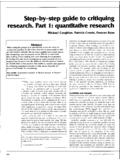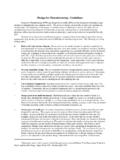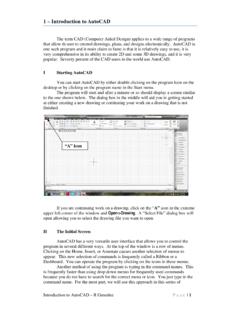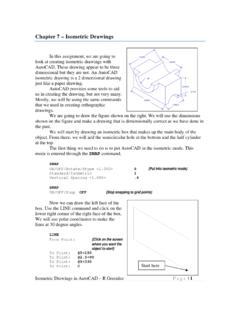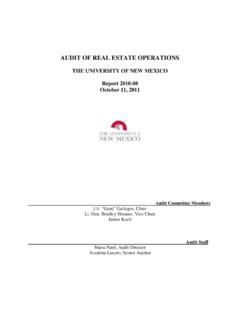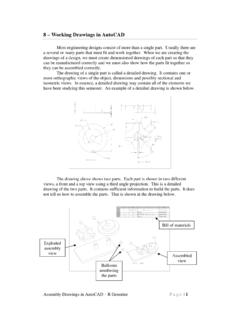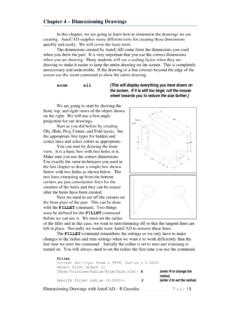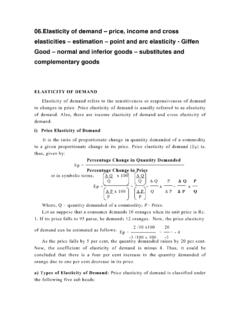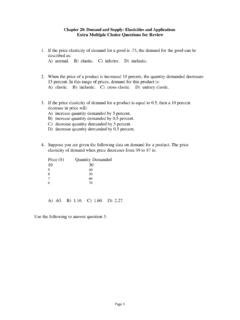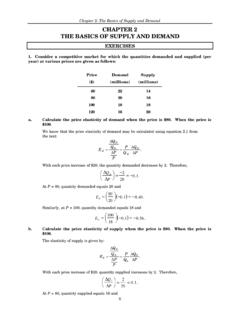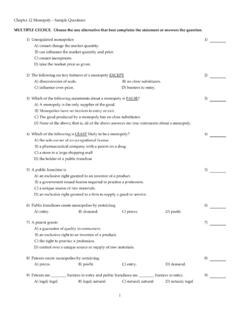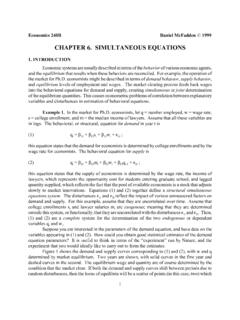Transcription of Chapter 5: Elasticity and Its Application Principles of ...
1 Chapter 5: Elasticity and Its Application Principles of Economics, 8th Edition N. Gregory Mankiw Page 1 1. Introduction a. Elasticity is a concept with broad applications in economics. b. It is the percentage change, usually in quantity, due to a percentage change in something else.
2 C. Percentages are used to avoid problems with units. 2. The Elasticity of demand : (% Change in Quantity/% Change in the Price) a. Elasticity is a measure of the responsiveness of quantity demanded or quantity supplied to one of its determinants. P. 90. b. The price Elasticity of demand and its determinants i. The ranges are: (1) Elastic if the ratio is greater than one and (2) Inelastic if the ratio is less than one. ii. Price Elasticity of demand is a measure of how much the quantity demanded of a good responds to a change in the price of that good, computed as the percentage change in quantity demanded divided by the percentage change in price.
3 P. 90. iii. Availability of close substitutes (1) This is the key to price elasticities with those with many substitutes have high elasticities and those with few substitutes having low elasticities. iv. Necessities versus luxuries (1) They are more strongly influenced by income with necessities have low income elasticities and luxuries have high income elasticities. v. Definition of the market (1) They become more elastic as the market is more narrowly defined. (a) Wonder Bread has a higher Elasticity than bread. vi. Time horizon (1) More substitutes become available or consumers become aware of them in the long run, thereby, increasing the Elasticity .
4 (2) This is true for non-durable goods, but it tends to be the opposite for durable goods. (a) They tend to be elastic in the short run and inelastic in the long run. c. Computing the price Elasticity of demand i. Price Elasticity = % Q/ % P. ii. Because demand curves are always negatively sloped, price elasticities are usually reported as positive numbers based on their absolute values. iii. The Midpoint Method: A Better Way to Calculate Percentage Changes and Elasticities (1) With two points, using the average avoids getting a different value when you go up versus going down.
5 Chapter 5: Elasticity and Its Application Principles of Economics, 8th Edition N. Gregory Mankiw Page 2 (2) Price Elasticity of demand = (Q2 - Q1)/(Q2 + Q1)/2 / (P2 - P1)/(P2 + P1)/2 iv. A numerical example: Price Yards Feet Inches $1 1 3 36 $.
6 50 2 6 72 v. In all cases, the Elasticity will be 1. vi. The Variety of demand Curves (1) The flatter the demand curve that passes through a given point, the greater the price Elasticity of demand . (2) The steeper the demand curve that passes through a given point, the smaller the price Elasticity of demand . (3) Figure 1: The Price Elasticity of demand . P. 93. (a) Perfectly inelastic, (b) Elasticity less than 1, (c) Elasticity equal to 1, (d) Elasticity greater than 1, and (e) Perfectly elastic. vii. FYI: A Few Elasticities from the Real World, P.
7 94. (1) These are only estimates. (2) Eggs = .1; Beef = viii. Total revenue and the price Elasticity of demand Effect on Total Revenue Elastic demand Inelastic demand Price Increases Decreases Increases Price Decreases Increases Decreases ix. Total revenue is the amount paid by buyers and received by sellers of a good, computed as the price of the good times the quantity sold. P. 94 (1) Figure 2: Total Revenue. P. 95. (2) Figure 3: How Total Revenue Changes When Price Changes: Inelastic demand . P.
8 96. (3) Figure 3: How Total Revenue Changes When Price Changes: Elastic demand . P. 96. viii. When demand is inelastic, price and total revenue move in the same Chapter 5: Elasticity and Its Application Principles of Economics, 8th Edition N. Gregory Mankiw Page 3 direction.
9 Ix. When demand is elastic, price and total revenue move in opposite directions. x. If demand is unit elastic (which is unusual), total revenue remains constant when the price changes. d. Elasticity and Total Revenue along a Linear demand Curve i. A linear demand curve is elastic at the top and inelastic at the bottom, so a reduction in price initially increases TR and then eventually reduces it. ii. However, it would be very unusual for a demand curve to be linear over a broad range of prices. iii. Figure 4: Elasticity of a Linear demand Curve.
10 P. 97. e. Other demand Elasticities i. The income Elasticity of demand is a measure of how much the quantity demanded of a goo d responds to a change in consumers income, computed as the percentage change in quantity demanded divided by the percentage change in income. P. 98 (1) Necessities have low and luxuries high income elasticities. (2) Inferior goods have negative income elasticities. (3) The high income elasticities of automobiles illustrate the problems associated with inducing people to take public transportation.

